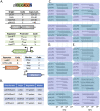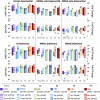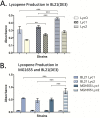Plasmids for Controlled and Tunable High-Level Expression in E. coli
- PMID: 36342148
- PMCID: PMC9680613
- DOI: 10.1128/aem.00939-22
Plasmids for Controlled and Tunable High-Level Expression in E. coli
Abstract
Controlled gene expression is crucial for engineering bacteria for basic and applied research. Inducible systems enable tight regulation of expression, wherein a small-molecule inducer causes the transcription factor to activate or repress transcriptional initiation. The T7 expression system is one of the most widely used inducible systems, particularly for high overexpression of proteins. However, it is well known that the highly active T7 RNA polymerase (RNAP) has several drawbacks, including toxicity to the host and substantial leaky expression in the absence of an inducer. Much work has been done to address these issues; current solutions require special strains or additional plasmids, making the system more complicated and less accessible. Here, we challenge the assumption that the T7 expression system is the best choice for obtaining high protein titers. We hypothesized that expression from strong inducible promoters expressed from high-copy plasmids could compete with expression levels obtained from T7 RNAP but that such promoters would possess improved control of transcription. Employing inducible systems from a toolbox we developed previously, we demonstrate that our plasmids consistently give higher outputs and greater fold changes over basal expression than the T7 system across rich and minimal media. In addition, we show that they outperformed the T7 system when we used an engineered metabolic pathway to produce lycopene. IMPORTANCE Genetic systems for protein overexpression are required tools in microbiological and biochemical research. Ideally, these systems include standardized genetic parts with predictable behavior, enabling the construction of stable expression systems in the host organism. Modularity of a genetic system is advantageous, so that the expression system can be easily moved into a host that best suits the needs of a given experiment. The T7 expression system lacks both predictability and stability and requires special host strains to function. Despite these limitations, it remains one of the most popular systems for protein overproduction. This study directly compared the T7 system to four inducible systems from our broad-host-range plasmid toolbox and demonstrated these alternative expression systems have distinct advantages over the T7. The systems are entirely plasmid-based and not constrained to a specific bacterial host, expanding the options for high-level protein expression across strains.
Keywords: T7 system; inducible expression; plasmid toolbox; protein overexpression.
Conflict of interest statement
The authors declare no conflict of interest.
Figures






Similar articles
-
Construction of synthetic T7 RNA polymerase expression systems.Methods. 2018 Jul 1;143:110-120. doi: 10.1016/j.ymeth.2018.02.022. Epub 2018 Mar 5. Methods. 2018. PMID: 29518499
-
Regulating the T7 RNA polymerase expression in E. coli BL21 (DE3) to provide more host options for recombinant protein production.Microb Cell Fact. 2021 Sep 26;20(1):189. doi: 10.1186/s12934-021-01680-6. Microb Cell Fact. 2021. PMID: 34565359 Free PMC article.
-
Escherichia coli chromosome-based T7-dependent constitutive overexpression system and its application to generating a phenylalanine producing strain.J Biosci Bioeng. 2018 Nov;126(5):586-595. doi: 10.1016/j.jbiosc.2018.05.014. Epub 2018 Jun 28. J Biosci Bioeng. 2018. PMID: 29958770
-
Tight transcriptional control mechanism ensures stable high-level expression from T7 promoter-based expression plasmids.Biotechnology (N Y). 1995 Feb;13(2):175-9. doi: 10.1038/nbt0295-175. Biotechnology (N Y). 1995. PMID: 9634760
-
Plasmid replication based on the T7 origin of replication requires a T7 RNAP variant and inactivation of ribonuclease H.Nucleic Acids Res. 2021 Aug 20;49(14):8189-8198. doi: 10.1093/nar/gkab596. Nucleic Acids Res. 2021. PMID: 34255845 Free PMC article.
Cited by
-
Escherichia coli cells evade inducible parE toxin expression by reducing plasmid copy number.Microbiol Spectr. 2024 Jun 4;12(6):e0397323. doi: 10.1128/spectrum.03973-23. Epub 2024 May 3. Microbiol Spectr. 2024. PMID: 38700352 Free PMC article.
-
Toward the Development of a Biosimilar Variant of Glucarpidase (Carboxypeptidase G2): Secretory Production, Optimization, and Immobilization.Mol Biotechnol. 2025 Jun 4. doi: 10.1007/s12033-025-01450-4. Online ahead of print. Mol Biotechnol. 2025. PMID: 40465023
-
Innovations, Challenges and Future Directions of T7RNA Polymerase in Microbial Cell Factories.ACS Synth Biol. 2025 May 16;14(5):1381-1396. doi: 10.1021/acssynbio.5c00139. Epub 2025 Apr 10. ACS Synth Biol. 2025. PMID: 40209062 Free PMC article. Review.
-
Automated Assembly of Programmable RNA-Based Sensors.bioRxiv [Preprint]. 2025 Aug 13:2025.08.12.669972. doi: 10.1101/2025.08.12.669972. bioRxiv. 2025. PMID: 40832206 Free PMC article. Preprint.
-
Integration of (S)-2,3-oxidosqualene enables E. coli to become Iron Man E. coli with improved overall tolerance.Biotechnol Biofuels Bioprod. 2023 Dec 10;16(1):191. doi: 10.1186/s13068-023-02444-7. Biotechnol Biofuels Bioprod. 2023. PMID: 38072928 Free PMC article.
References
Publication types
MeSH terms
Substances
LinkOut - more resources
Full Text Sources

